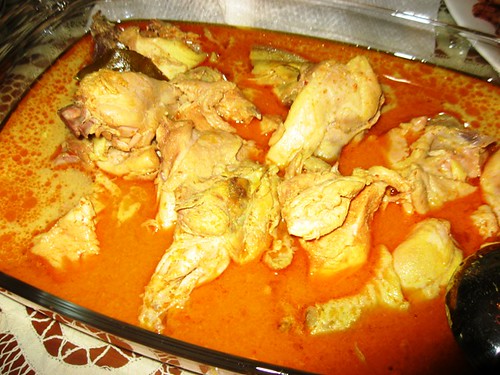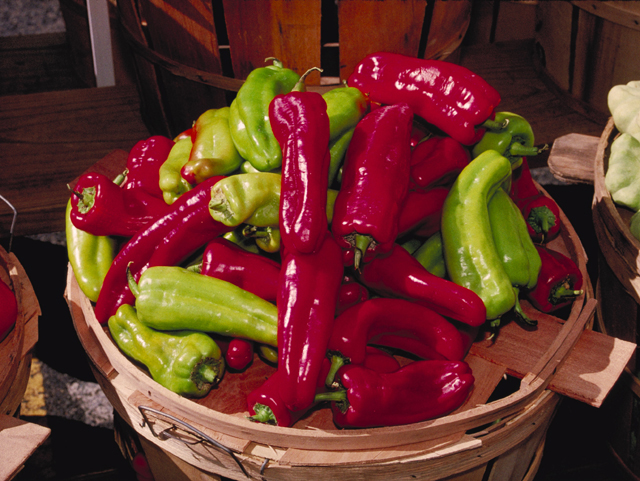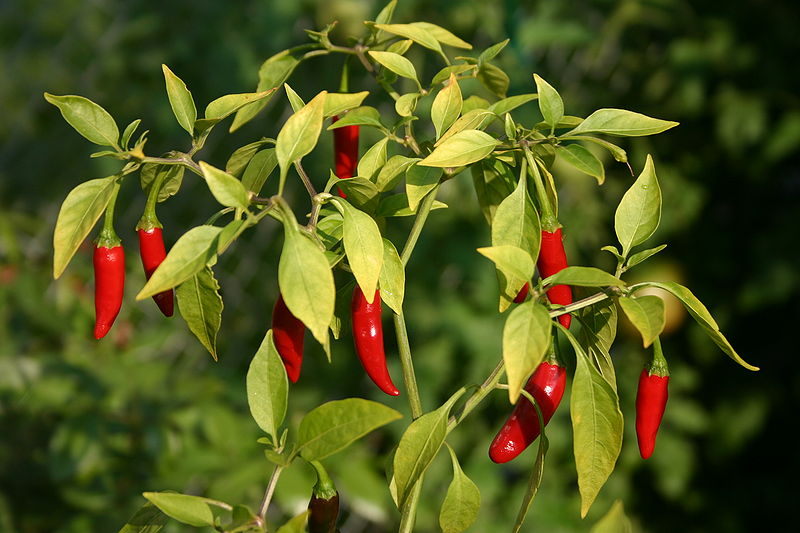Black pepper (
Piper nigrum) is a
flowering vine in the family
Piperaceae, cultivated for its
fruit, which is usually dried and used as a
spice and
seasoning. In dried form, the fruit is often referred to as peppercorns. Peppercorns, and the powdered pepper derived from grinding them, may be described as black pepper, white pepper, red/pink pepper, and green pepper, though the terms
pink peppercorns,
red pepper, and
green pepper are also used to describe the fruits of other, unrelated plants.
 Black pepper is native to South India and is extensively cultivated there and elsewhere in tropical regions. The fruit, known as a peppercorn when dried, is a small drupe five millimetres in diameter, dark red when fully mature, containing a single seed.
Black pepper is native to South India and is extensively cultivated there and elsewhere in tropical regions. The fruit, known as a peppercorn when dried, is a small drupe five millimetres in diameter, dark red when fully mature, containing a single seed.
Dried ground pepper is one of the most common spices in European cuisine and its descendants, having been known and prized since antiquity for both its flavour and its use as a medicine. The spiciness of black pepper is due to the chemical piperine. Ground black peppercorn, usually referred to simply as "pepper", may be found on nearly every dinner table in some parts of the world, often alongside table salt.
The word "pepper" is derived from the
Sanskrit pippali, the word for
long pepper via the
Latin piper which was used by the Romans to refer both to pepper and long pepper, as the Romans erroneously believed that both of these spices were derived from the same plant. The English word for pepper is derived from the
Old English pipor. The Latin word is also the source of
German pfeffer,
French poivre,
Dutch peper, and other similar forms. In the 16th century,
pepper started referring to the unrelated
New World chile peppers as well. "Pepper" was used in a figurative sense to mean "spirit" or "energy" at least as far back as the 1840s; in the early 20th century, this was shortened to
pep.
Varieties
 Black pepper is produced from the still-green unripe berries of the pepper plant. The berries are cooked briefly in hot water, both to clean them and to prepare them for drying. The heat ruptures cell walls in the fruit, speeding the work of browning enzymes during drying. The berries are dried in the sun or by machine for several days, during which the fruit around the seed shrinks and darkens into a thin, wrinkled black layer, the result of a fungal reaction.[citation needed] Once dried, the fruits are called black peppercorns.
Black pepper is produced from the still-green unripe berries of the pepper plant. The berries are cooked briefly in hot water, both to clean them and to prepare them for drying. The heat ruptures cell walls in the fruit, speeding the work of browning enzymes during drying. The berries are dried in the sun or by machine for several days, during which the fruit around the seed shrinks and darkens into a thin, wrinkled black layer, the result of a fungal reaction.[citation needed] Once dried, the fruits are called black peppercorns.
White pepper consists of the seed only, with the fruit removed. This is usually accomplished by allowing fully ripe berries to soak in water for about a week, during which the flesh of the fruit softens and decomposes. Rubbing then removes what remains of the fruit, and the naked seed is dried. Alternative processes are used for removing the outer fruit from the seed, including removal of the outer layer from black pepper produced from unripe berries.
In the U.S., white pepper is often used in dishes like light-colored sauces or mashed potatoes, where ground black pepper would visibly stand out. There is disagreement regarding which is generally spicier. They do have differing flavors due to the presence of certain compounds in the outer fruit layer of the berry that are not found in the seed.

Green pepper, like black, is made from the unripe berries. Dried green peppercorns are treated in a manner that retains the green colour, such as treatment with sulfur dioxide or freeze-drying. Pickled peppercorns, also green, are unripe berries preserved in brine or vinegar. Fresh, unpreserved green pepper berries, largely unknown in the West, are used in some Asian cuisines, particularly Thai cuisine. Their flavor has been described as piquant and fresh, with a bright aroma. They decay quickly if not dried or preserved.
A rarely seen[citation needed] product called pink pepper or red pepper consists of ripe red pepper berries preserved in brine and vinegar. Even more rarely seen, ripe red peppercorns can also be dried using the same colour-preserving techniques used to produce green pepper. Pink pepper from Piper nigrum is distinct from the more-common dried "pink peppercorns", which are the fruits of a plant from a different family, the Peruvian pepper tree, Schinus molle, and its relative the Brazilian pepper tree, Schinus terebinthifolius. In years past there was debate as to the health safety of pink peppercorns, which is mostly no longer an issue. Sichuan peppercorn is another "pepper" that is botanically unrelated to black pepper.
 Peppercorns are often categorised under a label describing their region or port of origin. Two well-known types come from India's Malabar Coast: Malabar pepper and Tellicherry pepper. Tellicherry is a higher-grade pepper, made from the largest, ripest 10% of berries from Malabar plants grown on Mount Tellicherry. Sarawak pepper is produced in the Malaysian portion of Borneo, and Lampong pepper on Indonesia's island of Sumatra. White Muntok pepper is another Indonesian product, from Bangka Island.
Peppercorns are often categorised under a label describing their region or port of origin. Two well-known types come from India's Malabar Coast: Malabar pepper and Tellicherry pepper. Tellicherry is a higher-grade pepper, made from the largest, ripest 10% of berries from Malabar plants grown on Mount Tellicherry. Sarawak pepper is produced in the Malaysian portion of Borneo, and Lampong pepper on Indonesia's island of Sumatra. White Muntok pepper is another Indonesian product, from Bangka Island.
The pepper plant
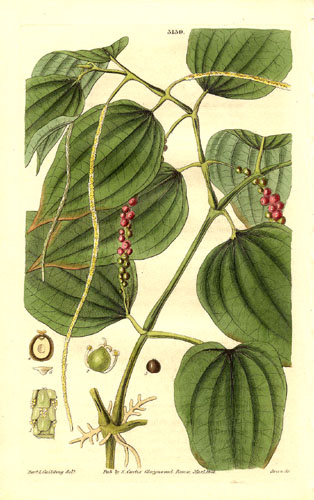 The pepper plant is a perennial woody vine growing to four metres in height on supporting trees, poles, or trellises. It is a spreading vine, rooting readily where trailing stems touch the ground. The leaves are alternate, entire, five to ten centimetres long and three to six centimetres broad. The flowers are small, produced on pendulous spikes four to eight centimetres long at the leaf nodes, the spikes lengthening to seven to 15 centimeters as the fruit matures.
The pepper plant is a perennial woody vine growing to four metres in height on supporting trees, poles, or trellises. It is a spreading vine, rooting readily where trailing stems touch the ground. The leaves are alternate, entire, five to ten centimetres long and three to six centimetres broad. The flowers are small, produced on pendulous spikes four to eight centimetres long at the leaf nodes, the spikes lengthening to seven to 15 centimeters as the fruit matures.
Black pepper is grown in soil that is neither too dry nor susceptible to flooding, moist, well-drained and rich in organic matter. The plants are propagated by cuttings about 40 to 50 centimetres long, tied up to neighbouring trees or climbing frames at distances of about two metres apart; trees with rough bark are favoured over those with smooth bark, as the pepper plants climb rough bark more readily. Competing plants are cleared away, leaving only sufficient trees to provide shade and permit free ventilation. The roots are covered in leaf mulch and manure, and the shoots are trimmed twice a year. On dry soils the young plants require watering every other day during the dry season for the first three years. The plants bear fruit from the fourth or fifth year, and typically continue to bear fruit for seven years. The cuttings are usually cultivars, selected both for yield and quality of fruit. A single stem will bear 20 to 30 fruiting spikes. The harvest begins as soon as one or two berries at the base of the spikes begin to turn red, and before the fruit is mature, but when full grown and still hard; if allowed to ripen, the
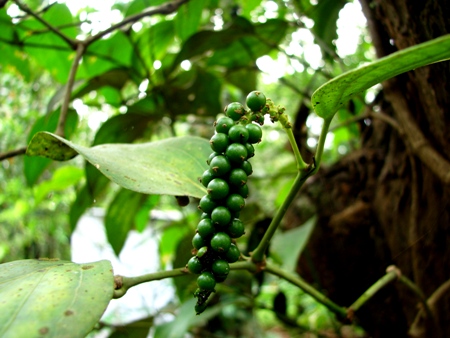
berries lose pungency, and ultimately fall off and are lost. The spikes are collected and spread out to dry in the sun, then the peppercorns are stripped off the spikes.
FlavourPepper gets its spicy heat mostly from the piperine compound, which is found both in the outer fruit and in the seed. Refined piperine, milligram-for-milligram, is about one percent as hot as the capsaicin in chilli peppers. The outer fruit layer, left on black pepper, also contains important odour-contributing terpenes including pinene, sabinene, limonene, caryophyllene, and linalool, which give citrusy, woody, and floral notes. These scents are mostly missing in white pepper, which is stripped of the fruit layer. White pepper can gain some different odours (including musty notes) from its longer fermentation stage.

Pepper loses flavour and aroma through evaporation, so airtight storage helps preserve pepper's original spiciness longer. Pepper can also lose flavour when exposed to light, which can transform piperine into nearly tasteless
isochavicine. Once ground, pepper's aromatics can evaporate quickly; most culinary sources recommend grinding whole peppercorns immediately before use for this reason. Handheld pepper mills (or "pepper grinders"), which mechanically grind or crush whole peppercorns, are used for this, sometimes instead of pepper shakers, dispensers of pre-ground pepper. Spice mills such as pepper mills were found in European kitchens as early as the 14th century, but the
mortar and pestle used earlier for crushing pepper remained a popular method for centuries after as well.
This article i grab from
wikipedia
 Star anise, star aniseed, badiane or Chinese star anise, (Chinese: 八角, pinyin: bājiǎo, lit. "eight-horn") is a spice that closely resembles anise in flavor, obtained from the star-shaped pericarp of Illicium verum, a small native evergreen tree of southwest China. The star shaped fruits are harvested just before ripening. It is widely used in Chinese cuisine, in Indian cuisine where it is a major component of garam masala, and in Malay/Indonesian cuisine. It is widely grown for commercial use in China, India, and most other countries in Asia. Star anise is an ingredient of the traditional five-spice powder of Chinese cooking. It is also one of the ingredients used to make the broth for the Vietnamese noodle soup called phở. It is used as a spice in preparation of Biryani in Andhra Pradesh, a south Indian State.
Star anise, star aniseed, badiane or Chinese star anise, (Chinese: 八角, pinyin: bājiǎo, lit. "eight-horn") is a spice that closely resembles anise in flavor, obtained from the star-shaped pericarp of Illicium verum, a small native evergreen tree of southwest China. The star shaped fruits are harvested just before ripening. It is widely used in Chinese cuisine, in Indian cuisine where it is a major component of garam masala, and in Malay/Indonesian cuisine. It is widely grown for commercial use in China, India, and most other countries in Asia. Star anise is an ingredient of the traditional five-spice powder of Chinese cooking. It is also one of the ingredients used to make the broth for the Vietnamese noodle soup called phở. It is used as a spice in preparation of Biryani in Andhra Pradesh, a south Indian State.










